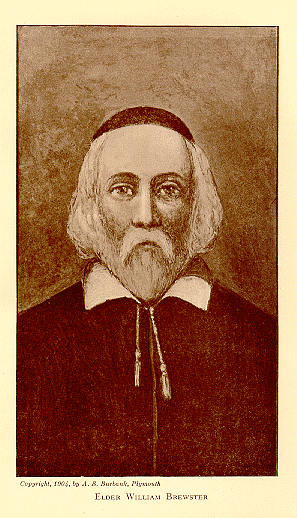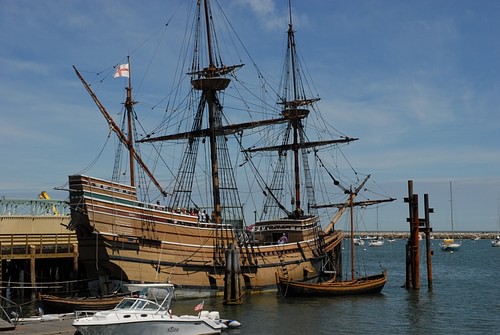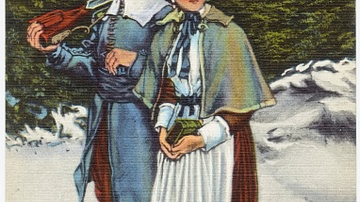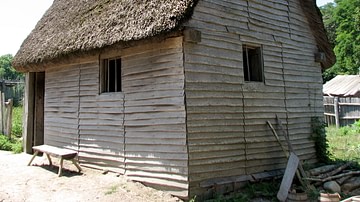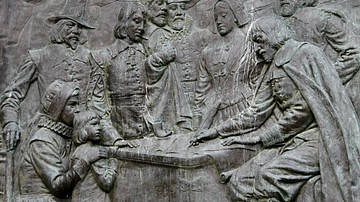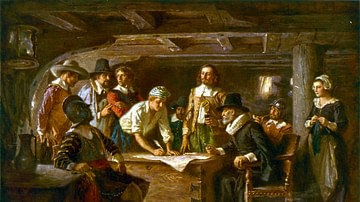The 102 Mayflower passengers were a diverse group made up of religious separatists (later known as pilgrims) and others referred to by the pilgrims as Strangers (people who did not share their faith). The ship also had a crew of approximately 30 (possibly 50) captained by Christopher Jones (l. c. 1570-1622 CE) of Rotherhithe, England. The separatists were seeking a new home where they could worship freely without fear of the ongoing persecution of the Anglican Church under King James I of England (r. 1603-1625 CE) and contracted with the merchant-adventurer Thomas Weston (l. 1584 - c. 1647 CE) for a ship to take them to the New World. Weston then enlisted the others (Strangers) to assist the separatists in establishing a colony and turning a profit for the investors who financed the expedition.
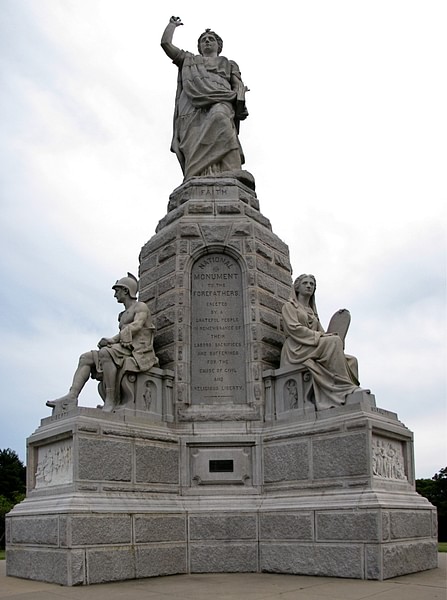
Accounts of the early days of the colony written by separatists William Bradford (l. 1590-1657 CE) and Edward Winslow (l. 1595-1655 CE) of the Mayflower, as well as those written later, ensured Plymouth Colony an almost mythic status less than 100 years after its founding. It is still regarded in this same way in the present era, and many citizens of the United States proudly claim direct descent from those who made the uncertain voyage to the New World aboard the Mayflower in 1620 CE.
The Separatists
The separatists were Christian fundamentalists influenced by the works of the Protestant theologian John Calvin (l. 1509-1564 CE) and, directly, by the former Anglican priest Robert Browne (l. 1550-1633 CE) who advocated the separation of “true believers” – those who understood the Bible as the literal Word of God and lived according to its precepts – from those who had been “deceived by Satan” and continued to regard human constructs, such as the Church, as an authority on sacred matters. The separatists were so-called from the verse in the biblical book of II Corinthians 6:17 reading “Come out from among them [the unbelievers] and be ye separate” which was interpreted to mean that only those who did so would be “saved” by Christ.
The congregation which would eventually migrate to the New World was established in the village of Scrooby, England and pastored by John Robinson (l. 1576-1625 CE) until 1607 CE when the Anglican Archbishop Tobias Matthew (l. 1546-1628 CE) ordered a number of them arrested on charges of heresy and sedition. King James I of England was the head of the Anglican Church and so any form of protest against the Church was understood as direct criticism of the king and so as treason. The separatists fled to Leiden, Netherlands, whose government was much more tolerant of religious diversity, where they established a new community.
In 1618 CE, however, one of their leading members, William Brewster (l. 1568-1644 CE) published a tract criticizing the Church's teachings. Officers were dispatched to arrest Brewster who was hidden by his friends, but it was understood by the congregation that, if they wanted to practice their faith without fear, they would have to leave Leiden. They contracted with Thomas Weston (l. 1584 - c. 1647 CE) to provide them with a ship and crew to bring them to the New World. One Captain Blossom, a friend or member of the congregation, purchased them a passenger ship, the Speedwell, and Weston rented a cargo ship, the Mayflower, to carry additional passengers and supplies. The Speedwell leaked, however, and so only the Mayflower would make the crossing to North America. Among the separatists onboard were:
Isaac Allerton, Sr. (l. c. 1586-1659 CE), his wife Nancy; son Bartholomew; daughters Remember and Mary, and servants John Hooke, John Howland, William Latham, Roger Wilder, and Desire Minter. Mary would live until 1699 CE and be celebrated as the last of the Mayflower passengers.
William Bradford (l. 1590-1657 CE) and his wife Dorothy. Dorothy would die (possibly from suicide) during the winter of 1620-1621 CE; in 1623 CE, he would marry Alice Southworth and have five children. Bradford became the second governor of Plymouth Colony after the death of John Carver (although often, incorrectly, identified as the first) and its chronicler. Bradford's Of Plymouth Plantation is considered a literary and historical classic, providing a first-hand account of the voyage of the Mayflower and establishment of the Plymouth Colony.
William Brewster (l. 1568-1644 CE) and his wife Mary; their sons Jonathan, Love, and Wrestling; daughters Patience and Fear. The Brewsters also took charge of two of the four children of Samuel More who had taken them from their mother's home after charging her with adultery. Richard and Mary More were turned over to the Brewsters as indentured servants while Jasper was indentured to John Carver and Ellen More to Edward Winslow. Why Samuel More turned the children over to the Leiden congregation is disputed but Bradford claims the father wanted to give his children a better life away from the shame of their mother's infidelity.
John Carver (l. 1584-1621 CE) and his wife Katherine traveled with their five servants (including a girl named Dorothy) and Jasper More. Carver and Robert Cushman were the chief negotiators with Weston in mounting the expedition, and Carver would become the Plymouth Colony's first governor before dying in 1621 CE. Katherine died soon after her husband.
James Chilton (l. c. 1556 - winter of 1620/1621 CE), his wife (name unknown), and their daughter Mary. James and his wife died the first winter, but Mary survived.
Francis Cooke (l. c. 1583-1663 CE) and his son John; his wife and other children remained in Leiden until the colony was firmly established.
John Crackston (also given as Craxton, l. c. 1575 - winter of 1620/1621 CE) and his son Jack.
Robert Cushman (l. 1577-1625 CE), with John Carver, secured the patent from the Virginia Company allowing for the establishment of a colony in the New World and negotiated with Weston for supplies. He began the voyage aboard the Speedwell and was welcomed aboard the Mayflower but elected to stay behind due to illness. He rejoined the colony in 1621 CE at Plymouth.
Moses Fletcher (l. c. 1564 - winter of 1620/1621 CE) who traveled alone and died in the first winter.
Edward Fuller (l. 1575 - winter of 1620/1621 CE) and his wife (name unknown) and their son Samuel. Fuller and his wife died in the first winter; Samuel survived and became a prominent member of the community after he was raised by his uncle.
Samuel Fuller (l. c. 1580-1633 CE), brother of Edward and one of the leading advocates in the congregation for resettlement in the New World. He was the congregation's doctor and traveled with his servant William Butten, the only passenger to die on the Mayflower voyage.
John Goodman (l. c. 1595 - c. 1627 CE) traveled alone and became lost in the woods while gathering thatch for roofing in January 1621 CE along with Peter Browne. The two men found their way back, but Goodman was crippled by frostbite after a night in the forest.
Digory Priest (l. c. 1579 - winter of 1620/1621 CE), brother-in-law of Isaac Allerton's wife.
Thomas Rogers (l. c. 1571 - winter of 1620/1621 CE) and his son Joseph; Thomas died in the first winter, but Joseph would survive and contribute to Plymouth Colony's development.
Edward Tilley (l. c. 1588 - winter of 1620/1621 CE) and his wife Ann with two charges, a nephew Henry Samson and niece Humility Cooper. Edward and Ann would not survive the first winter.
John Tilley (l. c. 1571 - winter of 1620-1621 CE) and his wife Joan and daughter Elizabeth; John and Joan did not survive the first winter.
Thomas Tinker (l. c. 1581 - winter of 1620/1621 CE) and his wife and son, all of whom died the first winter.
John Turner (l. c. 1590 - winter of 1620/1621 CE) and his two sons; all died the first winter.
William White (l. c. 1580 - winter of 1620/1621 CE) and his wife Susanna; son Resolved, and two servants, Edward Thompson and William Holbeck. His and Susanna's son Peregrine was the first child of the colony born onboard the Mayflower in North America. William died in the first winter and Susanna would later marry Edward Winslow.
Thomas Williams (l. 1582 - winter of 1620/1621 CE) traveled alone and died in the first winter.
Edward Winslow (l. 1595-1655 CE) and his wife Elizabeth with their servants Elias Story and George Soule and Edward's younger brother Gilbert. Edward was one of the more prominent members of the Plymouth Colony and, along with Bradford, its chief chronicler and later governor. Along with John Carver, he helped negotiate the peace with the Wampanoag Confederacy. Elizabeth died during the first winter and he would later marry the widow Susanna White and have five children.
The Strangers
The so-called Strangers were recruited by Thomas Weston to help the colonists establish the community in the New World and turn a profit for the investors. The Strangers came from various backgrounds and brought different skills and talents Weston thought would be useful but, in many cases, what these skills were is unknown. Among the Strangers were:
John Billington (l. c. 1580-1630 CE) and his wife Eleanor with two sons, John Jr. and Francis. Nothing is known of John's occupation nor why he was selected to join the expedition. Both his sons caused considerable problems for the colonists – Francis by almost blowing up the Mayflower by discharging a weapon near the gunpowder supply and John Jr. wandering off and being taken by the Nauset Native Americans. John Sr. was hanged in 1630 CE for murder, and Eleanor was whipped and stocked for slander.
Richard Britteridge (l. c. 1581 - winter of 1620/1621 CE) traveled alone as a free man, not an indentured servant, though nothing is known of his occupation.
Peter Browne (l. c. 1594 - 1633 CE), a weaver and friend of William Mullins who may have invited him on the expedition. Along with John Goodman, Browne became lost in the woods in January of 1621 CE, almost freezing to death after a night in the wilderness.
Richard Clarke (d. winter of 1620/1621 CE) seems to have traveled as a free man but nothing is known of him except his name.
Francis Eaton (l. c. 1596-1633 CE) traveled with his wife Sarah and newborn son Samuel. Francis was a carpenter and possibly the Mayflower's carpenter who helped save the ship when the central beam broke mid-voyage. His wife died during the first winter, and he would marry and outlive two more wives.
Richard Gardinar (d. c. 1651 CE) about whom nothing is known. He was possibly a sailor associated with the Mayflower crew.
Stephen Hopkins (l. 1581-1644 CE) traveled with his second wife Elizabeth and daughter Constance and son Giles from his first marriage, and son Damaris from his marriage to Elizabeth. He also brought two servants, Edward Doty and Edward Leister. His son Oceanus was born aboard the Mayflower at sea but would not live long, dying in 1627 CE. Hopkins was the only member of the expedition with experience in the New World, having been shipwrecked in Bermuda in 1609 CE and then traveling to the fledgling Jamestown Colony of Virginia. He returned to England in 1614 CE after hearing of the death of his first wife, Mary, and then signed on to the Mayflower expedition with the understanding it would be landing near Jamestown.
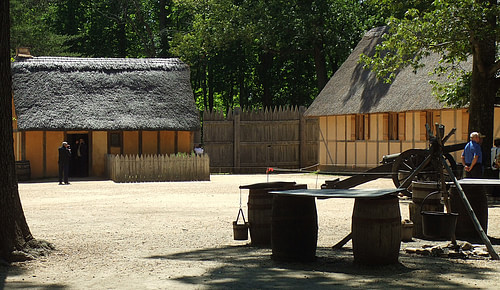
Edmund Margesson (d. winter of 1620/1621 CE) seems to have traveled as a free man but nothing else is known of him.
Christopher Martin (l. c. 1582 - winter of 1620/1621 CE), a merchant who traveled with his wife Mary, their son Nathaniel, his stepson Solomon Prower (also given as Prowe), and servant John Langemore. Martin was responsible for purchasing supplies for the expedition and seems to have been picked by Weston to supervise the voyage. He was accused by the congregation of misappropriation of funds before they left for North America and is not depicted favorably by Bradford. He was initially the governor of the passengers aboard the Speedwell and seems to have abused his power once aboard the Mayflower. He and his wife, son, and stepson did not survive the first winter.
William Mullins (l. c. 1572 - winter of 1620/1621 CE) traveled with his wife Alice, daughter Priscilla, son Joseph, and servant Robert Carter. He was a cobbler who boarded the Mayflower with over 200 pairs of shoes he planned to sell in the New World. Only Priscilla would survive the first winter, later marry John Alden, and become one of the more prominent members of the colony.
John Rigsdale (d. winter of 1620/1621 CE) traveled with his wife Alice. They both died the first winter and are thought to have been among the oldest passengers on the Mayflower, possibly in their late 60s.
Myles Standish (l. c. 1584-1656 CE) traveled with his first wife, Rose, who died the first winter. He would later marry his second wife, Barbara, who arrived in the colony in 1623 CE aboard the ship Anne. Standish was the military advisor for the expedition who designed and built the first fort and is credited by Bradford as one of the healthy members of the expedition who cared for the sick during the winter of 1620/1621 CE. He is among the most famous members of the Plymouth Colony, immortalized in the poem The Courtship of Miles Standish by Henry Wadsworth Longfellow (l. 1807-1882 CE) which presents him as part of a love triangle with Pricilla Mullins and John Alden.
Richard Warren (l. c. 1578-1628 CE) traveled alone, leaving his wife Elizabeth and their children to wait at home until the colony was established. He and his wife would have seven children in all once Elizabeth joined him in Plymouth, and many notable United States citizens claim the Warrens as ancestors, among them presidents Ulysses S. Grant and Franklin Delano Roosevelt.
Gilbert Winslow (l. 1600-1631 CE) traveled with his brother Edward Winslow but was not a member of the Leiden congregation. He helped establish the Plymouth Colony and then returned to England sometime before 1627 CE.
Captain & Crew
The captain (master) of the Mayflower was Christopher Jones, contracted by Thomas Weston. Among his crew were:
John Alden (l. c. 1598-1687 CE), among the best-known members of the expedition who would later marry Priscilla Mullins and become assistant to the governor of the colony. He was a cooper and carpenter by trade who maintained the barrels of beer, wine, and foodstuffs aboard the Mayflower and later assisted in building the first houses of the Plymouth Colony. He was only contracted to serve aboard the Mayflower and then return to England but elected to stay with the colonists at Plymouth.

John Clark, First Mate and Pilot of the Mayflower (dates unknown), an experienced mariner.
Robert Coppin, Master's Mate and pilot (dates unknown) with experience in North American travel.
Thomas English and Mr. Ely (dates unknown) both contracted for a year's service in establishing the colony who then returned to England in 1621 CE.
Andrew Williamson and John Parker (dates unknown), both master's mates.
Giles Heale (dates unknown), the ship's surgeon and general practitioner.
George Hurst (d. winter of 1620/1621 CE), the ship's cook.
William Trevor (dates unknown) hired by Weston to remain in Plymouth for one year, afterwards returning to England.
There were others only known by their names signed on the Mayflower Compact or by references made by Bradford or Winslow in their later accounts of the early days of the colony.
Conclusion
The 102 passengers and 30-man crew endured two months on the open sea in rough weather between 6 September and 11 November 1620 CE on the Mayflower, a 12-year old cargo ship never intended to transport passengers and never before used for a voyage of such a distance. Over 50% of the passengers and crew would die during the first winter. Bradford reports how, even though some members of the crew were rude and abusive to the separatists, the members of the congregation still cared for them when they were ill, and many converted to the separatist vision and later helped the community establish their settlement. Captain Jones is especially noted for helping save the colony during the first winter by mobilizing his crew for hunting and fishing expeditions to restock the supply of food.
The Plymouth Colony would finally establish itself through the help of the Native Americans Tisquantum (better known as Squanto, l. c. 1585-1622 CE), Samoset (also given as Somerset, l. c. 1590-1653 CE), and Ousamequin (better known by his title Massasoit, l. c. 1581-1661 CE). The story of the Native Americans and pilgrim founders of Plymouth continues to be celebrated in the United States of America every November at the holiday of Thanksgiving. The colony established by the separatists, Strangers, and crew not only survived but flourished to become not only the foundational settlement of New England but a central aspect of the narrative of the early history of the United States.
